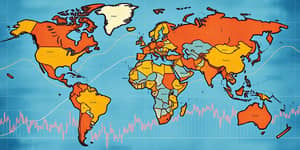In an era of interconnected economies, governments and central banks wield the exchange rate as a powerful tool. Competitive devaluation of currencies has emerged as a potent strategy to gain trade advantages, yet its ripple effects can undermine global prosperity.
Defining Currency Wars
At its core, a currency war involves deliberate actions by monetary authorities to weaken their own currency. By doing so, a nation can boost exports, discourage imports, and counteract trade barriers.
- Interest rate suppression to lower borrowing costs.
- Direct market intervention through foreign exchange operations.
- Verbal interventions and signaling to influence market expectations.
These measures typically spark tit-for-tat currency devaluations among trade partners, creating a cycle of retaliation and instability.
Historical Flashpoints and Contemporary Episodes
Currency conflicts are not new. From the 1930s to the present day, episodes of competitive devaluation have reshaped trade dynamics and geopolitical relationships.
- 1930s “Beggar-thy-neighbor” gold standard collapse.
- Brazil’s real depreciation in the 2010s.
- China’s yuan devaluation in 2015.
- The Trump administration’s tariffs and ensuing moves in 2025.
During the Great Depression, uncoordinated devaluations slashed trade growth by roughly 21%. In Brazil, the real plunged from approximately 2 to over 4 BRL per USD between 2014 and 2016, restoring export competitiveness but fueling domestic inflation. China’s surprise 2015 adjustment of the yuan rattled global markets, while the tariff-driven environment of 2025 reignited strategic currency moves across major economies.
Economic and Financial Impacts
War-like currency tactics carry profound consequences across multiple dimensions of economic activity.
Key impacts include:
- Distorted global capital flows into safe‐haven assets like U.S. treasuries.
- Altered commodity prices, given most are priced in USD.
- Heightened inflation in import‐reliant economies and deflation risks for exporters.
Moreover, rapid currency swings can erode consumer purchasing power and destabilize employment in both export and import sectors.
Geopolitical Dynamics and Policy Responses
Currency wars are often intertwined with broader geopolitical tensions. Trade imbalances, political pressure, and reciprocal tariff measures serve as common triggers.
Global economic stability concerns are magnified when powers like the U.S. and China engage in parallel currency strategies. China’s push for a digital yuan further challenges the dollar’s reserve status, adding a modern layer to the contest.
- Interest rate adjustments by major central banks.
- Quantitative easing programs expanding monetary bases.
- Direct foreign exchange interventions to buy or sell reserves.
Successful mitigation relies on multilateral coordination efforts across nations. Yet history shows that trust can fray quickly in the face of immediate national interests.
Systemic Risks and Future Outlook
Uncoordinated currency competition undermines the very trade it seeks to boost. Rapid global capital flight risks intensify financial contagion, especially in economies burdened by high foreign currency debt vulnerabilities.
Long‐term damage includes weakened policy transmission, as central banks struggle to influence real economic outcomes amid ongoing volatility.
Looking ahead, innovations in digital currencies and evolving geopolitical alliances will redefine how nations wield monetary power. Strengthening the frameworks of the IMF, BIS, and WTO remains vital to prevent currency conflicts from spiraling into full‐blown economic confrontations.
Strategies for Investors and Policymakers
While currency wars seldom dominate headlines, their financial repercussions are far‐reaching. Stakeholders can adopt measures to mitigate exposure and preserve stability.
Investors and policymakers alike should consider:
Safeguarding domestic purchasing power through diversified reserve allocations and prudent fiscal management. Emphasizing well-diversified foreign asset portfolios and maintaining robust contingency plans can cushion the blow of sudden currency shifts.
Conclusion
Currency wars stand at the intersection of economics and geopolitics, offering short‐term gains at the risk of long‐term discord. By championing cooperation and adopting comprehensive risk frameworks, the global community can transform these silent battles into opportunities for strengthened resilience.
References
- https://verifiedinvesting.com/blogs/education/the-currency-wars-how-exchange-rate-battles-shape-global-investment-flows
- https://www.dunham.com/FA/Blog/Posts/currency-wars-trade-tariffs-global-risk
- https://market-bulls.com/currency-wars-and-their-impact/
- https://www.currencytransfer.com/blog/expert-analysis/what-is-a-currency-war
- https://www.wealthformula.com/blog/currency-wars-strategies-for-hedging-wealth-in-uncertain-times/
- https://hw.online/blog/currency-war/
- https://tnfx.co/what-is-a-currency-war/










